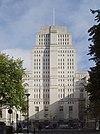Imperial College London
| Motto | Scientia imperii decus et tutamen (Latin)[note 1] |
|---|---|
Motto in English | Scientific knowledge, the crowning glory and the safeguard of the empire |
| Type | Public research university |
| Established | 1907 by Royal Charter[2] (1823 earliest medical school) |
| Endowment | £157.1 million (as of 31 July 2017)[3] |
| Budget | £1.027 billion (2017–2018)[3] |
| President | Alice Gast |
| Provost | Ian Walmsley |
| Visitor | The Lord President of the Council ex officio |
Academic staff | 3,765 (2016–2017) |
| Students | 17,690 (2016/17)[4] |
| Undergraduates | 9,520 (2016/17)[4] |
| Postgraduates | 8,170 (2016/17)[4] |
| Location | London , United Kingdom |
| Colours | Imperial Blue[5] |
| Affiliations | ACU AMBA EUA G5 Global Alliance of Technological Universities Golden Triangle LERU MedCity Russell Group SES |
| Website | www |
 | |
Imperial College London (IC) is a large university in central London.[6] It specialises in business, engineering, medicine and science.[7][8]
Imperial College was a constituent college of the University of London. It became fully independent in 2007, the 100th anniversary of its founding.[9]
Imperial is among the best universities. It ranks 2nd in the 2015 QS World University Rankings and 9th in the 2015 Times Higher Education World University Rankings.[10][11] Imperial ranked 22 in the 2014 Shanghai world rankings.[12]
Imperial's faculty and alumni include 15 Nobel laureates, 2 Fields Medalists, 70 Fellows of the Royal Society, 82 Fellows of the Royal Academy of Engineering and 78 Fellows of the Academy of Medical Sciences.[13]
Facilities
[change | change source]Imperial's main campus is in the South Kensington area of Central London. It is on the boundary between the Royal Borough of Kensington and Chelsea and the City of Westminster. Its main entrance is on Exhibition Road.
IC has a number of other campuses in Central London. With 525,233 square metres, it has the largest working estate of any higher education institution in the UK.[14]
Imperial has around 14,700 full-time students and 3,330 academic and research staff.[15] It had a total income of £694 million in 2009/10, of which £297 million was from research grants and contracts.
Imperial is ranked 26th in the world (and 5th in Europe) in the 2010 Academic Ranking of World Universities,[16] 7th in the world (and 4th in Europe) in the 2010 QS World University Rankings,[17] and 9th in the world (and 3rd in Europe) in the 2010 Times Higher Education World University Rankings.[18]
There are currently 14 Nobel Prize winners and two Fields Medal winners amongst Imperial's alumni and current and former faculty.[19][20]
Imperial is a member of the G5, the League of European Research Universities, Oak Ridge Associated Universities and the Russell Group. It forms part of the 'Golden Triangle' of British universities.[21]
History
[change | change source]Imperial was formed indirectly by Prince Albert. Under his guidance, the Crown bought land in South Kensington to establish educational and cultural institutions. The area was referred to as "Albertopolis" by sceptics. The area included the Natural History Museum, the Victoria and Albert Museum, the Science Museum, the Royal Albert Hall and the Imperial Institute.[22][23] The Imperial Institute was opened by Queen Victoria, who laid the first brick.[24]
References
[change | change source]- Annual Report and Accounts 2013–14. Imperial College London. [1] Archived 2014-12-31 at the Wayback Machine
- ↑ "The College crest". Imperial College. Retrieved 29 January 2019.
- ↑ PJGILL. "Charitable status". Archived from the original on 21 September 2013. Retrieved 30 September 2014.
- ↑ 3.0 3.1 "Annual Report and Accounts 2017–18" (PDF). Imperial College London. Retrieved 15 December 2018.
- ↑ 4.0 4.1 4.2 "2016/17 Students by HE provider, level, mode and domicile" (CSV). Higher Education Statistics Agency. Retrieved 25 March 2018.
- ↑ "Brand colours". Imperial College London. Retrieved 28 Nov 2018.
- ↑ "officially The Imperial College of Science, Technology and Medicine". Archived from the original on 2009-03-26. Retrieved 2011-04-22.
- ↑ "Strategy". Archived from the original on 2012-11-13. Retrieved 2011-04-22.
- ↑ "About us". Imperial College Healthcare NHS Trust. Archived from the original on 2 December 2015. Retrieved 23 January 2011.
- ↑ "University of London: Imperial College leaves University of London". Archived from the original on 2011-05-22. Retrieved 2011-04-22.
- ↑ "QS World University Rankings® 2014/15". Top Universities. 2014-09-11. Retrieved 2015-03-10.
- ↑ "World University Rankings 2014-2015". Times Higher Education. October 2014. Retrieved 2015-03-10.
- ↑ ""ARWU - Imperial College, London". Shanghai Ranking Consultancy. 2014". Archived from the original on 2015-02-15. Retrieved 2015-06-08.
- ↑ "Award winners | Imperial College London". Imperial.ac.uk. Retrieved 2015-03-10.
- ↑ "Imperial College - Centenary website - Did you know". Imperial.ac.uk. 2006-11-06. Retrieved 2011-03-23.
- ↑ "Statistics Pocket Guide 2009–10" (PDF). Imperial College London. Archived from the original (PDF) on 10 August 2011. Retrieved 17 November 2010.
- ↑ "Top 100". Academic Ranking of World Universities - 2010. Archived from the original on 22 August 2010. Retrieved 1 October 2010.
- ↑ "QS World University Rankings Results 2010". QS Quacquarelli Symonds Limited. Archived from the original on 3 April 2011. Retrieved 1 October 2010.
- ↑ "Top 200". Times Higher Education. Retrieved 1 October 2010.
- ↑ "Nobel Laureates associated with Imperial College". Imperial College London. Archived from the original on 6 October 2014. Retrieved 4 October 2010.
- ↑ "Fields Medalists associated with Imperial College". Imperial College London. Archived from the original on 18 January 2012. Retrieved 24 October 2010.
- ↑ "'Golden triangle' to win funding riches". Times Higher Education. 11 February 2010. Retrieved 2 September 2010.
- ↑ "History of Imperial College" (PDF). Archived from the original (PDF) on 2017-08-09. Retrieved 2015-06-07.
- ↑ "Ted Talks Imperial College London HIstory". Archived from the original on 2015-04-02. Retrieved 2015-06-07.
- ↑ "A timeline of College Developments". Imperial College London.
Notes

